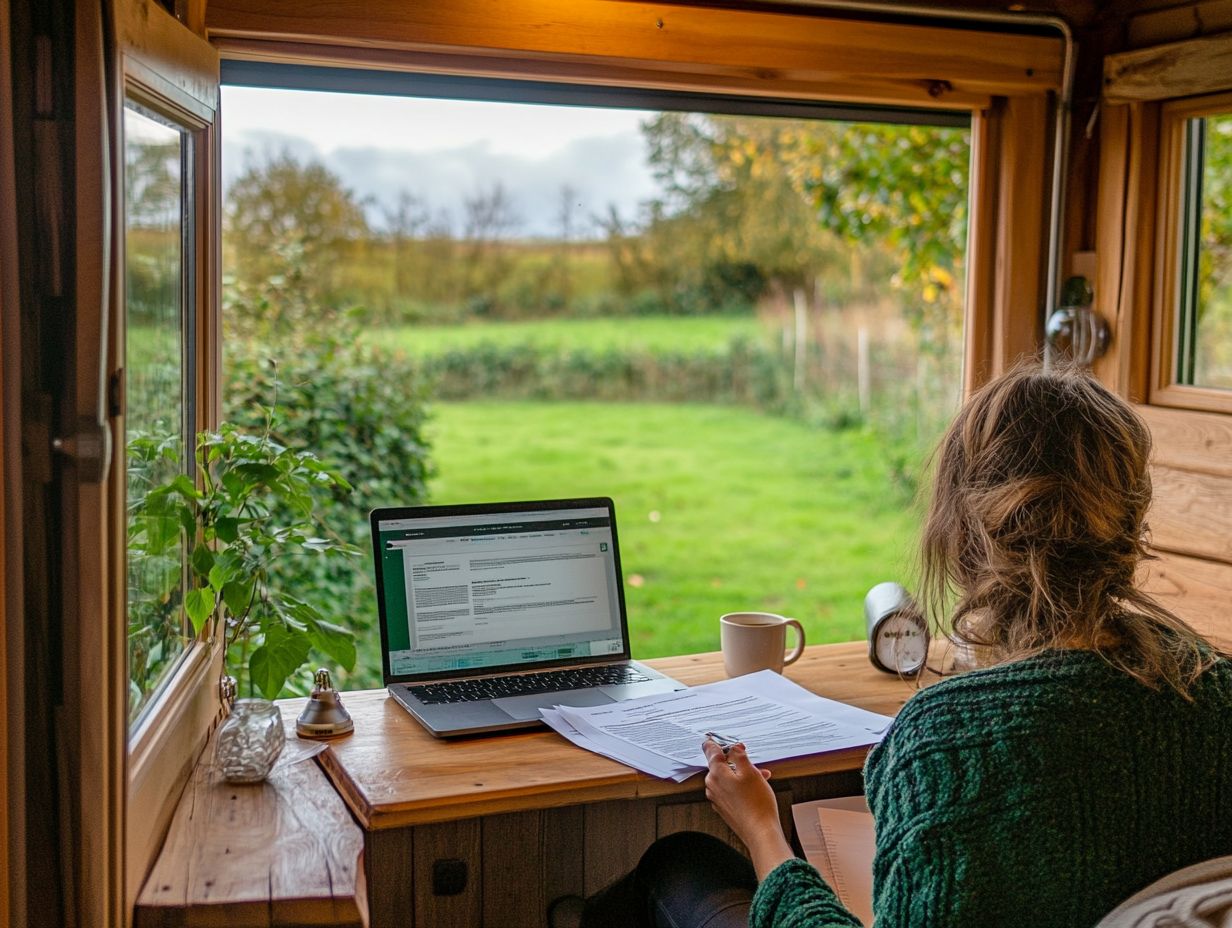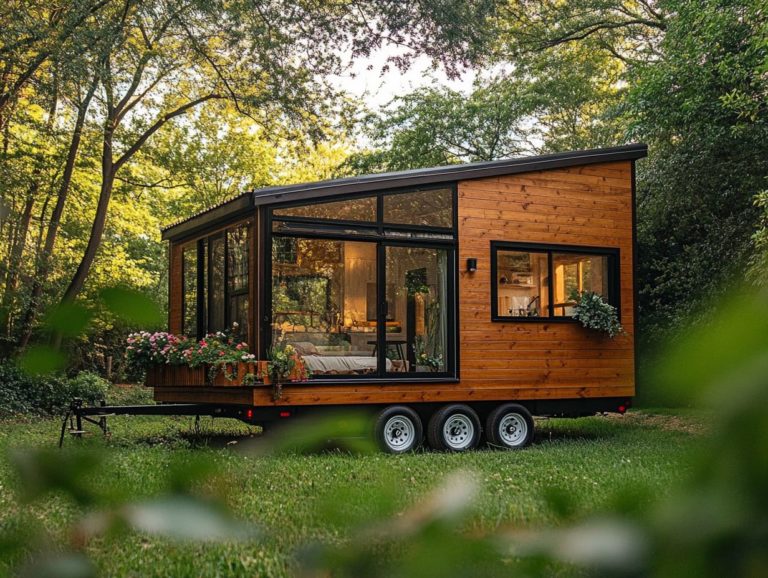How to Navigate Tiny House Insurance?
Navigating the realm of tiny house insurance can indeed feel daunting, particularly given the unique challenges associated with living in a compact space. Get ready to explore the world of tiny house insurance! This guide will empower you to make smart choices for your cozy haven.
This article lays out everything you need to know about tiny house insurance, guiding you from the basics to the various types of coverage available. You ll discover the factors that impact insurance rates, receive practical tips for selecting the ideal provider, and uncover strategies to save on premiums.
Whether you re a seasoned tiny house dweller or just dipping your toes into this lifestyle, this guide equips you to make informed decisions for your cozy haven.
Contents
Key Takeaways:

- Understand what Tiny House Insurance is and its importance in protecting your investment.
- Be aware of the types of coverage available, including property and liability coverage.
- Consider location, size, and construction materials when determining insurance rates, and research and compare different providers before making a decision.
Understanding Tiny House Insurance
Grasping the nuances of Tiny House Insurance is crucial for anyone contemplating the compact living lifestyle embodied by tiny homes. These distinctive abodes, typically under 400 square feet, necessitate specialized insurance policies designed to meet their unique needs.
As the allure of tiny houses continues to grow in the marketplace, it s vital for you to familiarize yourself with the available insurance options. Knowing the various coverage types and factors that influence insurance costs is essential.
Moreover, many tiny homeowners pursue certification from organizations like the National Organization of Alternative Housing (NOAH). This certification can significantly affect their insurance requirements and premiums.
What is Tiny House Insurance?
Tiny House Insurance is a specialized form of homeowners insurance crafted specifically for your unique tiny home lifestyle.
Unlike traditional homeowners insurance, which typically caters to larger properties, tiny house insurance addresses the distinct challenges and risks that come with compact living spaces. This type of insurance usually encompasses coverage for personal property, liability, and even the structure itself whether it s on wheels or anchored to a permanent foundation.
It s crucial for you, whether you’ve chosen a professionally built certified home or taken the DIY route, to familiarize yourself with the details of tiny house insurance policies. Understanding these details ensures you have adequate financial protection and peace of mind, especially given the often limited resources and unique features that define tiny homes.
Types of Coverage Available
When contemplating tiny house insurance, it s essential to grasp the different types of coverage available. These options can greatly impact your overall protection and the peace of mind you experience while residing in your tiny home.
Property Coverage
Property coverage in tiny house insurance protects your tiny home and the personal belongings inside. This ensures that you can enjoy your cozy space worry-free, knowing your essential appliances, fixtures, and furniture are safeguarded.
This coverage encompasses not only the walls and roof but also the essential appliances, fixtures, and furniture that make your tiny space livable. It extends to outdoor structures like decks and storage sheds, ensuring that your entire property is safeguarded.
Properly documenting your personal belongings is crucial, as it streamlines the insurance claims process should theft or damage occur. Keeping an inventory complete with photos and receipts is essential because insurers often require proof of ownership and value.
By ensuring accurate documentation, you can maximize your compensation and minimize disputes during claims, highlighting the vital importance of personal property coverage and comprehensive property coverage.
Liability Coverage

Liability coverage protects you from lawsuits and claims related to accidents or injuries on your property. This is vital in the tiny house community, where shared spaces can increase risks.
Think of this type of insurance as your safety net. It ensures that legal fees and medical expenses tied to such incidents are taken care of. For example, if a guest happens to slip and fall while visiting your tiny home, liability coverage steps in to help manage the costs related to their medical treatment and any ensuing legal claims.
This coverage is a must-have for tiny house owners, who may have limited space and, as a result, a higher likelihood of accidents due to crowded living conditions or unique layouts. Consider scenarios like a fire sparked by a malfunctioning appliance; it could lead to disputes with neighbors if damage extends beyond your property lines.
In such cases, this coverage becomes invaluable for safeguarding against unexpected liabilities. Act now to ensure you re protected against these risks!
Factors Affecting Insurance Rates
Numerous factors can significantly influence insurance rates for tiny houses. By understanding these elements, homeowners can make informed decisions regarding their coverage options.
Location and Size of Tiny House
The location and size of your tiny house significantly influence your insurance rates, as these elements directly impact the way insurance companies evaluate potential dangers.
For instance, if your tiny home is perched in a coastal area prone to hurricanes, you can expect to pay higher premiums compared to a home nestled in a more temperate region. Similarly, if you reside in an urban environment with elevated crime rates, your insurance costs may rise further.
Insurance providers carefully consider the risks associated with specific geographical areas. It s essential for tiny homeowners to grasp how their surroundings and the tiny house size can affect overall insurance pricing.
Interestingly, smaller structures might qualify for unique coverage options, potentially leading to savings on premiums.
Construction Materials and Techniques
The materials and construction methods you choose for your tiny house can have a significant impact on both your insurance costs and the types of coverage available to you.
When you opt for traditional framing methods, you ll likely discover easier access to conventional insurance policies, as these structures tend to be more familiar to insurers.
If you decide to go for innovative construction techniques, like modular designs or shipping container homes, you might encounter a more complex insurance landscape, which could lead to higher premiums or limited coverage options.
Compliance with local tiny house regulations also influences your insurance choices. Zoning laws are rules about how land can be used, while building codes are standards for construction. Homes that adhere to these regulations typically enjoy more favorable terms.
Understanding how your construction methods and regulatory compliance interact is essential for securing the best insurance solutions for your tiny living experience.
Choosing the Right Insurance Provider
Selecting the ideal insurance provider is essential for tiny house owners, as it significantly influences the quality and breadth of the coverage options at your disposal.
Making this choice thoughtfully ensures you receive the protection you need for your unique living space.
Explore your insurance options today and find the provider that best meets your needs!
Research and Comparison

Conducting thorough research is essential for tiny homeowners. It helps secure the best policies tailored to unique needs.
By evaluating a range of options, you ll be thrilled to find the right balance between affordability and comprehensive coverage. Key aspects to consider include:
- Liability protection
- Personal property insurance
- Disaster coverage benefits
Don t underestimate the importance of customer service reputation. Seeking out reviews and ratings can provide valuable insight into how providers manage claims and support their policyholders. This thoughtful approach can lead to significant peace of mind and financial security for tiny home dwellers.
Tips for Reducing Insurance Costs
Reducing insurance costs for tiny homes is a goal many homeowners aspire to achieve. By implementing effective strategies, you can unlock substantial savings on your insurance premiums.
Maximizing Discounts
Maximizing discounts is a savvy strategy to lower your insurance premiums while ensuring you have adequate coverage tailored to your living situation.
Seizing various savings opportunities, such as bundling your home insurance with auto or RV coverage, can significantly reduce your overall costs. Maintaining a clean credit record can also unlock additional discounts, as insurers typically reward responsible financial behavior.
If you re part of a tiny house community, your membership might grant you exclusive discounts through group policies or associations dedicated to tiny living.
Installing high-quality locks and security systems can lead to further reductions, allowing you to protect your investment without straining your budget.
Minimizing Risks
Minimizing the risks associated with tiny home living can lead to reduced insurance costs and improved coverage options for homeowners.
To achieve this, explore practical strategies that enhance both safety and compliance with local regulations. Installing safety features like fire alarms, carbon monoxide detectors, and secure locking systems is essential for protecting your belongings and ensuring the well-being of everyone in your home.
Regular maintenance checks like inspecting electrical systems, assessing roof integrity, and examining plumbing can save you from costly damages and health hazards down the line. Adhering to tiny house regulations not only guarantees compliance but also helps steer clear of potential legal fees and insurance claims that could arise from violations.
Frequently Asked Questions
What is the purpose of tiny house insurance?

Tiny house insurance is designed to protect your tiny house and its contents from unexpected events such as theft, fire, or natural disasters. It can also provide liability coverage if someone is injured on your property.
Do I need insurance for my tiny house?
While some states may not require insurance for tiny houses on wheels, it is still highly recommended to have coverage. Accidents and disasters can happen, and having insurance can help protect your investment.
What factors affect the cost of tiny house insurance?
The cost depends on your house’s value, location, type of coverage, and insurance provider. Factors such as the age and condition of your tiny house, as well as your personal insurance history, may also play a role in the cost.
Are there different types of tiny house insurance?
Yes, there are different types of tiny house insurance available. These include comprehensive coverage, liability coverage, and personal property coverage. It’s important to carefully review your options and choose the coverage that best fits your needs.
How can I find the right insurance for my tiny house?
Research and compare different insurance providers to find the right coverage for your tiny house.
Consider consulting with agents who specialize in tiny house insurance. They can help you find the best policy for your needs.
What should I do if I need to make a claim?
If you need to make a claim, contact your insurance provider right away.
They will walk you through the claims process and assist you in gathering necessary documentation.
Document any damages and keep all repair or replacement receipts handy.






